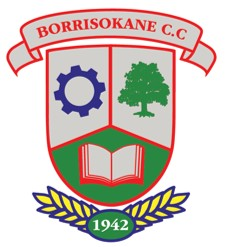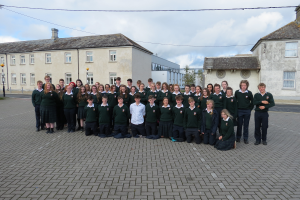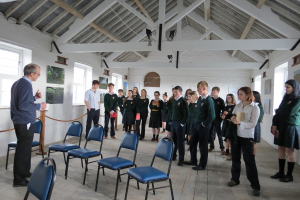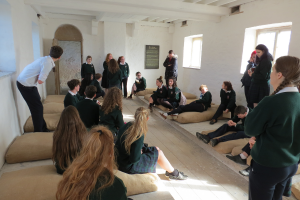On the 17th of October, 49 students from Borrisokane Community College visited the Portumna Workhouse. Our tour group consisted of TY and 5th Year history students and 5th year art students. The teachers that accompanied us on the trip were Aoife Forde, our history teacher, and Eileen Forde, our art teacher. When we arrived, we were greeted by our tour guide. He talked to us about what life was like for people living in the workhouse.
Young children from birth to two years of age stayed with their mothers, while any other young girls from the age of two to fifteen were separated. They were put to work and put into school with other girls their age. Any girls over the age of fifteen were sent straight to work. They had jobs such as cooking, cleaning, laundry and minding the children of the workhouse. For young boys and men, the process was very similar however they had much more physical jobs such as breaking rocks, white washing the walls and sweeping the yards.
The workhouse owners wanted to make it as uncomfortable as possible, they did this by having only one fireplace in the huge bedrooms. The bedrooms were also heavily vented so that the room would be freezing. Windows were up higher than normal so that family members weren’t able to look out at each other.
Next the visiting group were brought into what used to be the girls’ classroom and watched a documentary about the Portumna Workhouse. Some of what was said shocked us, it’s hard to believe that people lived off such a small amount of food. Adults had two meals a day, children were luckier as they received an extra meal. For breakfast stir-about, watered down porridge was served. Dinner was a serving of potatoes and a glass of milk, in the evening children received some bread.
Many people associate the workhouses with the years of the famine (1846-1852). However, the story of the workhouses in Ireland spans a period of 80 years. Workhouses were established for the people and families who couldn’t support themselves financially. They were brought into the workhouse where, in return for their hard work, they were given a place to live, food to eat and education for their children. One of the worst things about workhouses was the fact that families were split up as soon as they entered the workhouse and the chance of them ever being reunited were very slim. For this reason, workhouses became known as “the most hated institution ever established in Ireland”.
The reason behind our trip to the workhouse was to appreciate the history of our own school, Borrisokane Community College which was once a workhouse. The workhouse was built between 1848 and 1850. The Borrisokane workhouse was a similar size and layout to the workhouses in Urlingford, Clonakilty and Mitchelstown.
In 2015, Borrisokane Community College established the “BCC Heritage Project” Students are currently making wooden bi-lingual signs to mark and remember all the historic sites on which the school is built. These include the workhouses’, bakery, laundry, infirmary, boys and girls dormitories and the graveyard. Students have all been analysing and digitalizing all the old school rolls since the school was opened in 1942.
The tour of the workhouse in Portumna made us appreciate more our history and more of us are now interested in the workhouse in our school. We find it really hard to believe that when we sit in class each day we are sitting in the remains of a workhouse.
Written by Mickela McGrath and Siofra Buckley





